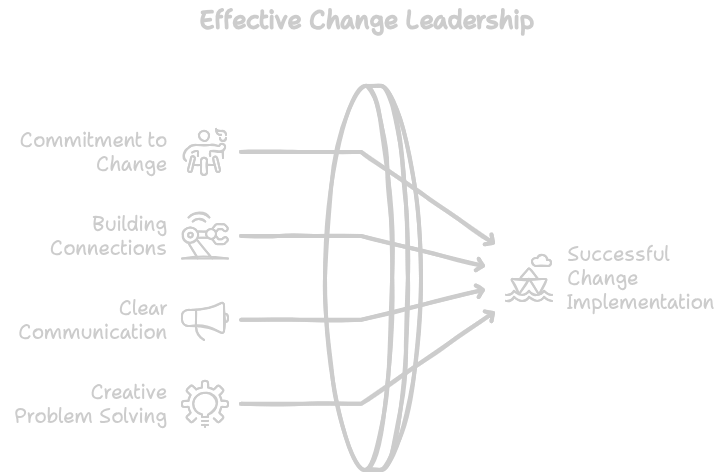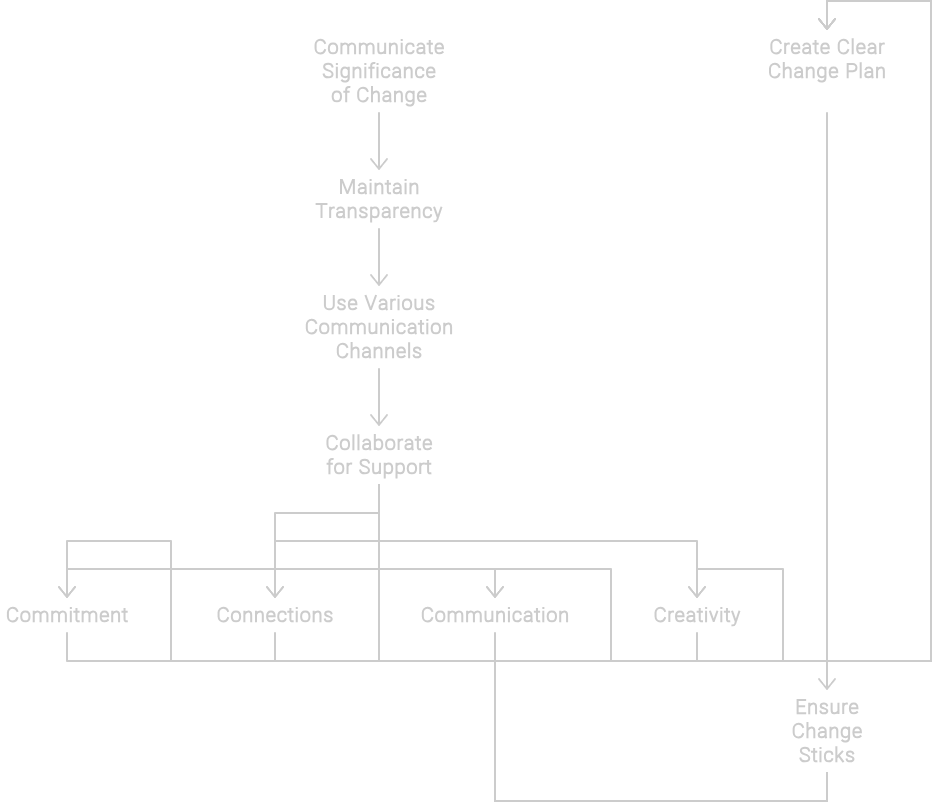The 4 C’s: Keys to Change Management
Change management can be tough, but it can be done well with the right approach. The 4 C’s – communication, collaboration, commitment, and consistency – are important principles that can help organizations through change. Embracing these principles can help businesses navigate transitions, engage employees, and achieve long-term success. Let’s look at how the 4 C’s are crucial for successful change management and how they can be put into action in organizations.
Skills Change Leaders Need

Being Committed to the Change
Committing to change in a team or organization means openly welcoming and actively participating in the transition. This sets an example and shows dedication to the new direction. To stay committed despite challenges, it’s important to communicate the benefits of change, provide support, and involve team members. Leaders can foster commitment by building trust, encouraging innovation, and recognizing those who embrace change.
This creates a positive culture that benefits the whole organization.
Building Connections with Your Team
Leaders can build connections with their team members through regular meetings, one-on-one talks, and team-building activities. This creates a positive, supportive work environment that fosters trust and collaboration. Encouraging social interaction, like team lunches, strengthens interpersonal connections.
Leaders can set expectations, provide feedback, and actively listen to team members to foster clear communication. Various communication channels and an open-door policy promote transparency and build trust.
Leaders can encourage innovation and experimentation to promote creative problem-solving. This involves allowing team members to share ideas, supporting professional development, and acknowledging creative solutions. Opportunities for cross-departmental collaboration can also be beneficial.
Clear and Open Communication
Leaders can ensure clear and open communication with their team in a few ways:
- Setting clear expectations and goals.
- Being transparent about decisions and changes.
- Actively listening to feedback and concerns from team members.
- Providing regular updates and opportunities for open dialogue.
Leaders can also encourage open communication within their team by:
- Fostering a culture of trust.
- Promoting open discussions.
- Addressing any misconceptions or misunderstandings promptly.
- Using platforms like town hall meetings, feedback sessions, and one-on-one discussions to encourage team members to voice their thoughts and concerns openly during periods of change.
Creative Problem Solving
Leaders need to be creative problem solvers when facing challenges and obstacles. Thinking creatively helps them find new and innovative solutions, especially during times of change.
For example, suppose a leader’s team is resistant to change. In that case, they can use creative problem-solving to communicate the benefits of change differently, involve the team, and address their concerns positively.
To promote creative problem-solving within their teams, leaders can create a work environment that supports risk-taking and new ideas. They can also hold brainstorming sessions for team members to share diverse perspectives and work together on creative solutions. Moreover, leaders can offer training for employees to improve their creative problem-solving skills, empowering them to contribute meaningfully to the change process. These strategies help teams adapt to change more effectively.
The Main Steps of Change Management

Make Everyone See Why Change Matters
Leaders can effectively communicate the significance of change by showing a strong commitment to the new direction, providing clear and consistent communication, and fostering strong connections with the team.
Openly communicating the reasons for the change and its potential benefits for the organization helps ensure that every team member understands and embraces the need for change.
Maintaining transparency and clear communication throughout the change process is essential to emphasize its importance and impact.
Using various communication channels, such as team meetings, emails, and one-on-one discussions, can help ensure that the message of change is effectively conveyed to all team members.
Work Together for Strong Support
Leaders can effectively collaborate to build strong support for change within their organizations by using the four Cs: Commitment, Connections, Communication, and Creativity.
- Demonstrating commitment to the change can inspire and motivate teams to follow suit.
- Building connections fosters a sense of community and shared purpose, which is important for garnering strong support.
- Open and clear communication ensures that everyone is fully informed and on the same page regarding the changes taking place.
- Creative problem-solving can help navigate the challenges of change management. It allows leaders to find innovative solutions and foster a supportive environment within the team.
By using these strategies, leaders can create a change-positive culture that promotes collaboration, trust, and resilience among team members during times of change.
Make a Clear Plan
To create a clear change plan, the leader should communicate it effectively to the team. Regular, transparent communication is key. This includes explaining the reasoning behind the change, the expected outcomes, and each team member’s role. It’s important to encourage open dialogue, address concerns, and make adjustments as needed.
The leader should ensure the change plan is flexible. This involves building contingency plans and involving the team in identifying potential roadblocks. Setting realistic timelines and milestones can help evaluate progress and make necessary adjustments.
Make Sure the Change Sticks
Leaders can ensure that the change implemented in their organization sticks and becomes a permanent part of the culture by focusing on the four Cs of change management: Commitment, Connections, Communication, and Creativity.
This involves nurturing a commitment to change initiatives at the leadership level and among team members. It also means building connections with individuals who can act as change champions and advocates.
Moreover, clear and open communication is required to reinforce and sustain the change. This includes regularly sharing updates, addressing concerns, and seeking employee feedback.
By embracing these 4 C’s, leaders can maintain strong support and commitment to the change among team members. This ultimately ensures its longevity and successful integration into the organization’s culture.
Finding the Right Change Manager

When choosing a change manager, it’s essential to consider more than just their experience and qualifications. Also, look at their commitment, connections, communication, and creativity.
These qualities are crucial for creating a positive culture for change within an organization and leading successful change efforts.
A change manager should be able to communicate effectively with their team, build strong connections, and lead cultural change through clear, consistent, and persuasive communication. They should also be able to creatively solve problems and navigate the challenges of implementing change.
To assess a potential change manager, evaluate their past experiences, conduct behavioral interviews, and use hypothetical scenarios to gauge their problem-solving skills and creativity.
These attributes and strategies go beyond the traditional job description and are essential for a change manager’s success in leading and managing organizational change.
Leading a Culture That Welcomes Change

A leader can strongly commit to change in several ways: actively participating in the change process, setting an example, and ensuring the team understands why the change is essential. They can do this by dealing with concerns and resistance and consistently discussing the change’s benefits.
To communicate the need for change and its benefits and encourage open communication among the team, a leader can hold regular team meetings to discuss the upcoming changes, give opportunities for feedback and ideas, and be open about why the change is happening. Also, having an open-door policy and listening to the team’s concerns and ideas can help with open communication.
A leader can also support creative problem-solving and connect with the team by creating a culture that values new ideas and different ways of thinking. This means giving opportunities for coming up with new ideas, noticing and rewarding creative solutions, and giving team members the power to take charge of the change. Building connections within the team can mean doing team-building activities, having one-on-one meetings, and creating a welcoming environment where everyone feels listened to and important.

Vizologi is a revolutionary AI-generated business strategy tool that offers its users access to advanced features to create and refine start-up ideas quickly.
It generates limitless business ideas, gains insights on markets and competitors, and automates business plan creation.


